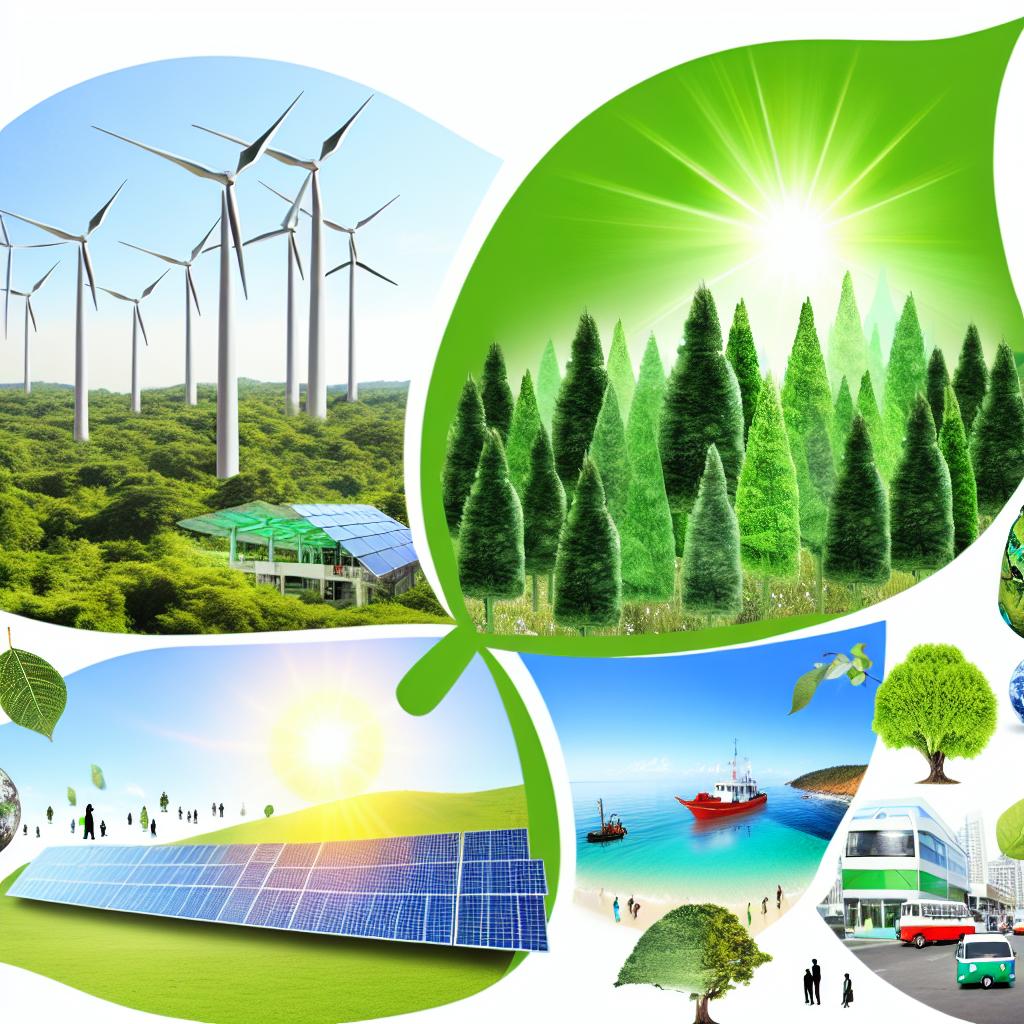
1. Renewable Energy Expansion
Solar, wind, geothermal, and hydroelectric energy are critical for reducing reliance on fossil fuels and cutting greenhouse gas emissions.
2. Energy Efficiency in Buildings
Retrofitting buildings with better insulation, efficient windows, and smart technology reduces energy waste and cuts down emissions.
3. Electric Transportation
Expanding electric vehicle (EV) infrastructure and promoting electric buses, trains, and bikes are vital to reducing transportation emissions.
4. Carbon Capture and Storage (CCS)
Capturing carbon dioxide from industrial processes and power plants and storing it underground can mitigate emissions from hard-to-abate sectors.
5. Reforestation and Afforestation
Planting new forests and restoring degraded ones can absorb CO₂ from the atmosphere and restore biodiversity.
6. Protecting Existing Forests
Preserving existing forests is crucial for maintaining carbon stores, protecting wildlife, and safeguarding indigenous lands.
7. Sustainable Agriculture Practices
Techniques like crop rotation, agroforestry, and organic farming can increase soil health, reduce emissions, and preserve ecosystems.
8. Soil Carbon Sequestration
Practices that enrich soil carbon, like cover cropping and reduced tillage, help store CO₂ in soil, improving crop resilience.
9. Regenerative Agriculture
Regenerative practices go beyond sustainability by actively improving soil health, biodiversity, and water cycles.
10. Alternative Proteins
Reducing dependence on traditional livestock with plant-based proteins and lab-grown meat lowers methane emissions and land use.
11. Waste Reduction and Management
Reducing, reusing, and recycling materials minimizes landfill waste and lowers emissions from waste processing.
12. Composting Organic Waste
Composting reduces methane emissions from organic waste in landfills and returns valuable nutrients to the soil.
13. Circular Economy Initiatives
Designing products and services to be reusable, recyclable, or compostable reduces waste and conserves resources.
14. Improved Public Transportation
Investing in accessible, efficient public transit reduces reliance on private cars and lowers transportation emissions.
15. Green Building Design
Using sustainable materials and incorporating energy-efficient designs in new buildings reduces their environmental footprint.
16. Urban Green Spaces
Green spaces in cities reduce urban heat, improve air quality, and provide habitats for wildlife.
17. Smart Grids and Energy Storage
Modernizing the grid with energy storage solutions and smart technology ensures efficient use of renewable energy.
18. Climate-Resilient Infrastructure
Designing infrastructure to withstand climate impacts, such as floods and wildfires, reduces vulnerabilities.
19. Ocean Conservation and Blue Carbon
Protecting coastal ecosystems, like mangroves and seagrasses, helps absorb CO₂ and protects marine biodiversity.
20. Reducing Food Waste
Tackling food waste from production to consumption reduces emissions associated with food production and waste disposal.
21. Sustainable Fisheries Management
Protecting fish stocks and marine ecosystems ensures long-term sustainability and food security.
22. Bioenergy with Carbon Capture and Storage (BECCS)
BECCS captures emissions from bioenergy production and stores them, offering a carbon-negative solution.
23. Low-Emission Livestock Management
Practices like methane-reducing feed additives can lower livestock emissions without reducing productivity.
24. Education and Public Awareness
Raising awareness and educating communities about climate issues encourages sustainable practices and lifestyle changes.
25. Policy and Carbon Pricing
Implementing carbon pricing, taxes, and incentives drives businesses and individuals to reduce their carbon footprint.
26. Corporate Sustainability
Encouraging businesses to adopt sustainable practices, reduce emissions, and commit to net-zero targets is vital for systemic change.
27. Clean Cookstoves for Developing Countries
Clean cookstoves reduce indoor pollution and emissions from wood or charcoal cooking methods in low-income communities.
28. Biodiversity Conservation
Protecting ecosystems and endangered species supports climate stability by maintaining healthy ecosystems.
29. Carbon Offsetting
Offsetting emissions through verified projects, like forest conservation or renewable energy, can balance out unavoidable emissions.
30. Battery Recycling and Second-Life Uses
Recycling batteries and finding secondary uses extends their life, conserves resources, and reduces waste.
31. Desalination Powered by Renewables
Solar- or wind-powered desalination provides fresh water without relying on energy-intensive methods.
32. Urban Farming and Vertical Agriculture
Growing food in urban areas or vertically reduces transport emissions and conserves space.
33. Climate-Smart Water Management
Efficient irrigation, rainwater harvesting, and watershed protection ensure water availability despite climate stresses.
34. Low-Carbon Cement and Concrete Alternatives
Innovations like carbon-sequestering concrete reduce emissions from traditional cement production.
35. Artificial Photosynthesis
Research into technologies that mimic natural photosynthesis could capture CO₂ and produce clean energy.
36. Geothermal Energy
Utilizing Earth's heat provides a constant, renewable energy source with a low environmental impact.
37. Oceanic Renewable Energy (Tidal and Wave Power)
Harnessing tidal and wave energy can provide consistent power with minimal land use.
38. Advanced Nuclear Energy
New nuclear technologies, like small modular reactors, offer low-carbon energy with enhanced safety features.
39. Hydrogen Fuel Production
Clean hydrogen, produced through electrolysis using renewable energy, offers a zero-emission fuel alternative.
40. Distributed Renewable Energy Solutions
Decentralized energy production, such as rooftop solar, empowers communities and enhances energy resilience.
41. Forest and Grassland Fire Management
Preventative measures and managed burns reduce wildfire risks and related emissions.
42. Electric and Hydrogen-Powered Aviation
Innovations in aircraft design and alternative fuels are essential for reducing emissions in aviation.
43. Carbon Negative Cement
Companies are developing cement that captures CO₂ during its production process, reducing its net emissions.
44. Sustainable Urban Planning
Cities designed for walkability, efficient transit, and reduced urban sprawl lower emissions and enhance quality of life.
45. Wildlife Corridors and Habitat Restoration
Connecting habitats ensures biodiversity and ecosystem health, helping species adapt to climate shifts.
46. Restoration of Wetlands
Wetlands store vast amounts of carbon and play a crucial role in flood prevention and water purification.
47. Desertification Prevention
Sustainable land practices and afforestation in arid regions prevent desert expansion and promote resilience.
48. Microgrids for Rural Electrification
Microgrids powered by renewables can bring clean energy to remote areas, improving lives and cutting emissions.
49. Eco-Friendly Tourism
Sustainable tourism minimizes the environmental impact of travel, promoting conservation and local economies.
50. Climate Adaptation for Vulnerable Communities
Supporting resilience programs for communities facing extreme weather events safeguards livelihoods and lives.
Moving Forward Together
By adopting and advocating for these solutions, we can all play a part in mitigating climate change. Each solution is a stepping stone towards a cleaner, more sustainable planet, and every action we take collectively pushes us closer to that goal.

